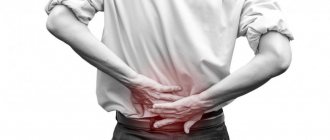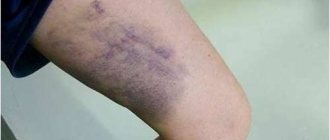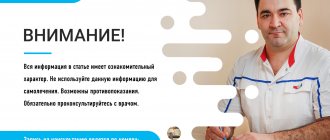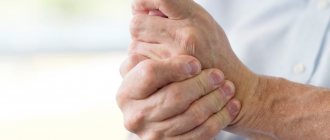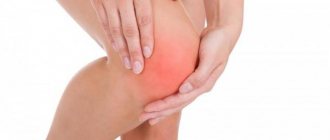Author
: Grachev Ilya Illarionovich
Editor
: Efremov Mikhail Mikhailovich
Date of publication: 05/13/2014 Date of update: 06/25/2021 All doctors of the clinic
- Tablets and ointments for neck pain
- Severe neck pain due to coronavirus and ARVI
- Diagnostics
There is no adult who has never felt neck pain in his life. Every fourth woman and every sixth man constantly experience it. A sedentary lifestyle and time spent at the computer aggravate the problem. Neck pain can also occur due to arthrosis of the shoulder joint and any other disease in this area, the upper back and arms, or the back of the head. From this article you can learn everything about neck pain and how to eliminate it.
Causes of neck pain
The most common causes are the following diseases:
- Cervical osteochondrosis, complicated by protrusion or herniation of intervertebral discs. The most common and important cause of neck pain. The pain is associated with pinching of the spinal nerve roots by partially or completely destroyed intervertebral discs. The pain is very strong, sudden, can be localized only in the neck (on one or both sides) or radiate to other areas - to the head, back of the head, arm, back, under the shoulder blade, etc. Treatment consists of pain therapy, restoration of the cartilage tissue of the discs and strengthening the neck muscles. Sometimes such patients require the help of a neurosurgeon to remove the destroyed disc.
- Ankylosing spondylitis (rheumatoid spondylitis, ankylosing spondylitis) is an autoimmune inflammatory process in the joints of the cervical spine. The disease usually develops gradually unnoticeably, spreading along the spine from bottom to top. The cervical region is the last to be affected. It manifests itself as pain in the neck, stiffness of movement, which goes away after the start of physical activity. Over time, the pain intensifies and the spine becomes immobile. Long-term treatment with a rheumatologist will help.
- Arthrosis of the facet joints of the cervical spine (uncovertebral arthrosis). The cause of pain in the neck and back of the head in this case is degenerative-dystrophic changes in the small joints connecting the cervical vertebrae. Often has a professional origin, develops when working in a stationary state with a bowed or forcedly turned head, or after suffering injuries. Symptoms: pain at the site of the lesion, radiating to the shoulder and crunching when moving, sometimes headaches, dizziness, high or low blood pressure, hearing impairment. Treatment by a neurologist and rheumatologist.
- Torticollis is a change in the position of the neck that prevents the head from turning and other movements. It can be congenital (in children) and acquired (in adults) after injuries, against the background of rough skin scars, persistent spasm of the cervical and occipital muscles during degenerative-dystrophic and inflammatory processes in the spine and surrounding soft tissues. Symptoms: tilt of the head and raised shoulder on the affected side, pain in the neck and back of the head when trying to tilt the head in the opposite direction. Pain increases with physical activity and stress. Treatment can be conservative (for spasms) and surgical, carried out by a surgeon or orthopedist-traumatologist.
- Myofascial pain syndrome (MPS) is associated with irritation of the nerve endings in the muscles, which leads to their spasm and pain. The main causes of neck pain with MBS are:
- microtrauma due to regular long-term muscle tension (forced position of the head when working at a computer, driving a car, when performing some repetitive movements, etc.;
- congenital structural features of the neck – torticollis, etc.;
- any diseases of this part of the spine;
- keeping the neck immobile for a long time (wearing a Shants collar for various diseases and injuries of the spine);
- compression of the muscles of the cervical and occipital region by surrounding soft and hard tissues for a long time;
- hypothermia - an aseptic inflammatory process develops in the neck muscles;
- prolonged stress - leads to spasm of the blood vessels that feed the muscles, disruption of metabolic processes and muscle contractility: they can remain in a spastic state for a long time. Symptoms: aching painful sensations in the back and sides of the neck, aggravated by physical activity. A hard, painful, tense muscle is felt in the form of a cord, on which, when palpated, you can find the most painful point (trigger). Painful waves from the trigger can radiate to other areas and internal organs. Treatment is carried out by a neurologist.
What exactly hurts in the neck
In the cervical spine, pain (cervicalgia) is most often caused by various types of disorders in the vertebrae. This is due to the structural features of this segment of the spine.
- There are a total of 7 vertebrae in the cervical spine (C1 – C7); they are smaller than other vertebrae and have an oblong body:
- the first cervical vertebra C1 or atlas has no body and underlying intervertebral disc; instead of a disc, C1 is connected to C2 by a unique Cruvelier joint with articular surfaces on the arch of C1 and a special formation (tooth) of C2;
- the bodies of the cervical vertebrae touch on the sides due to the uncinate processes - the raised edges of the bodies of the underlying vertebrae; these connections are called uncovertebral joints (they are not found in other parts of the spine);
- on the sides near the vertebral body there are wide transverse processes with a hole in the middle; the hole is necessary for the passage of the vertebral artery supplying the brain.
Such structural features of the cervical spine make it very mobile and at the same time susceptible to various types of injuries. The neck muscles are weaker than the muscles of other parts; they are not able to withstand high loads, especially if a person leads a sedentary lifestyle and spends a long time in a static position (for example, working at a computer). Painful muscle spasm accompanies any disease of the spine.
Clinical anatomy of the neck
In case of degenerative-dystrophic diseases of the spine, as well as arthritis of the facet (between individual vertebrae) joints, bone growths or swollen soft tissues can compress the vertebral artery, which leads to impaired blood supply to the brain, headaches and dizziness. Pain can also be a consequence of compression of the spinal roots extending from the spinal cord. Along the brachial nerve plexus such pain radiates to the arm.
Cervical myositis
The condition when the neck is severely blown is called “cervical myositis” in medical language. Determining the exact cause of the problem can be difficult, because it does not make itself felt immediately, but only after some time after exposure to the irritating factor. Here are the main factors that cause cervical myositis:
- drafts;
- sudden changes in temperature;
- prolonged uncomfortable head position (for example, during sleep);
- severe muscle tension (for example, during work);
- nervous tension;
- a complication after a cold, sore throat or flu.
First aid for neck pain - what to do
Neck pain can increase gradually, but sometimes it appears acutely, suddenly in the form of a lumbago with irradiation to other areas. It is difficult to endure such suffering. What to do, how to get rid of them?
Tablets and ointments for neck pain
Emergency self-help algorithm:
- Take a sedative - panic only aggravates the situation; you can take: 20 drops of Corvalol (Valocordin) or a Validol tablet under the tongue; these drugs not only soothe, but also dilate blood vessels, which in turn helps reduce muscle spasm and associated pain; You can also take 1 – 2 tablets of valerian extract or any other sedative that you have on hand.
- Take pain medication (optional):
- Paracetamol – 500 mg tablet orally or rectal suppository in the same dosage;
- Ketorolac (Ketorol) – 10 mg tablet orally;
- nimesulide (Nise) – 1 tablet 100 mg orally.
- To get rid of aching pain, you can use external pain relievers:
- ointments:
- emulgel Voltaren, gel Diclofenac - active ingredient diclofenac;
- gels Ketonal, Bystrumgel (ketoprofen);
- Nise gel (nimesulide);
- patches: Voltaren (with diclofenac), KetoPlastin (with ketoprofen), Versatis (with lidocaine).
Exercises for neck pain
If the pain is not very strong, is aching in nature, and is combined with stiffness, then you can try to get rid of it with the help of exercises. They need to be performed smoothly, without making sudden movements. An approximate set of exercises that relieve pain:
- starting position (IP) – lying on your back, head on a flat pillow; Press your head hard against the pillow and hold until you count 5; take a break and repeat; do 5 – 7 approaches;
- IP - lying on your left side, head on a flat pillow; raise your head and hold it in this position until the count of 5; take a short break, and then at least five approaches;
- IP - lying on your side on the right; repeat the previous exercise on the right side;
- IP - lying on your stomach, hands clasped at the back of your head; raise your head up, resisting with your hands; each approach – 5 seconds with a short break, repeat 5 – 7 times.
It is contraindicated to relieve severe acute pain with exercises.
In such cases, it is better to keep the neck still, using, for example, a Shants collar. But prolonged immobilization leads to weakening of the muscle corset and aggravation of the situation. Therefore, the Shants collar can be used to reduce pain before consulting a doctor. Only a specialist can determine the duration of immobilization.
After completely or partially eliminating the pain syndrome on your own, you need to see a doctor, otherwise it will return and it will be quite difficult to relieve it. The specialists of the Paramita clinic will help you to forget about your suffering forever.
Exercises for neck pain
What not to do if you have neck pain
If you often have neck pain, you should remember that you should not:
- being in a forced position for a long time with a tense neck - a painful muscle spasm develops;
- lift weights, perform heavy work - microtrauma occurs to the spine with the tissues located near it, gradual destruction of cartilaginous and bone structures;
- often be exposed to stress - they are accompanied by vascular spasms, which negatively affects blood circulation and the condition of the spine;
- smoking, drinking alcohol frequently – contributes to persistent vasoconstriction;
- hypothermia - the muscles located near the spine become inflamed, myositis develops;
- sleeping on a high soft pillow means staying in an uncomfortable static position for a long time;
- make sudden turns of the head - sudden pinching of the nerve and the appearance of severe pain are possible.
When you need to see a doctor urgently
Do not hesitate to seek medical help if:
- pain in the neck occurs regularly and is not always completely relieved by painkillers;
- you have experienced a painful attack for the first time or have already repeatedly experienced it, when any movement brings severe suffering;
- pain syndrome is accompanied by general disorders: fever, chills, etc.;
- suddenly there was an acute short-term pain in the neck on the left, radiating to the arm, shoulder blade or to the back of the head - a sign of an acute circulatory disorder in the area of the heart muscle (angina attack);
- sudden attacks of headache and dizziness appeared, sometimes with loss of consciousness - a sign of compression of the vertebral artery.
If such symptoms appear, there is no point in treating yourself: this will only worsen the problem. No folk remedies or grandmother’s advice will help.
Only a doctor can help relieve pain by developing an individual treatment plan based on the examination and establishment of an accurate diagnosis. If you are in doubt about which doctor to contact, go to an appointment with a therapist, he will understand the situation and, if necessary, refer you to another specialist.
Crunching in joints - when to worry
Joint pain at rest
Basic treatment measures
If you have a cold neck, how to cure this ailment? The following basic list of measures can be identified:
- Light self-massage of the neck and shoulder area using ointments. If the lymph nodes are inflamed, this procedure is contraindicated.
- Taking non-steroidal anti-inflammatory drugs.
- Taking antipyretics if your temperature rises.
- Applying warming ointments followed by wrapping in a warm scarf.
- Applying a warm vodka compress.
- Ensuring relaxation of the neck muscles. It is advisable to spend as much time as possible lying down on a comfortable pillow.
- Elimination of drafts and temperature changes.
- Carrying out novocaine blockade for unbearable pain.
Types of neck pain and how to deal with it
Pain syndrome can manifest itself in different ways: only on one side of the neck or everywhere, locally or radiate to other parts of the body. Let's try to figure out what the appearance of pain indicates and what to do in each specific case.
Severe neck pain due to coronavirus and ARVI
Any viral infections can be accompanied by neck pain. This is due to intoxication caused by the infectious agent. Once the person recovers, these symptoms go away.
But in some people, after a few days or weeks after a viral infection, the pain syndrome appears again, sometimes it is accompanied by swelling in the spine and stiffness of movement (the head has difficulty turning to the sides) in the morning.
This condition requires immediate examination, as it may be associated with autoimmune processes in the facet (connecting vertebrae) joints of the spine.
Coronavirus infection has a serious impact on the immune system, causing various disruptions to its functioning. If a person has a predisposition to an autoimmune process (close relatives suffering from such diseases), then it is quite possible that a viral infection will serve as a starting point (trigger) for its onset. What to do: see a therapist or rheumatologist.
Severe neck pain and fever
Fever with neck pain is a symptom of inflammation
If severe pain in the neck appears suddenly and is accompanied by fever, then this indicates the presence of an acute inflammatory process:
- viral infection or exacerbation of some chronic inflammatory process (bronchitis, sinusitis, etc.) - in this case, the disease is also accompanied by catarrhal symptoms - cough and runny nose; what to do: if the pain is not too severe and the temperature is not high, you can wait to see a doctor; persistence of pain after recovery should be a reason to consult a doctor;
- bacterial purulent inflammatory processes - abscesses, phlegmons; what to do: consult a surgeon, since the symptoms can only be eliminated through surgery;
- autoimmune process in the joints of the cervical spine; the first symptoms appear a few days or weeks after the acute inflammatory process, there are no catarrhal symptoms; what to do: consult a doctor immediately; self-medication is contraindicated.
Severe pain in the neck, radiating to the head
Sometimes acute, sudden pain appears in the neck in the spinal region, radiating to the head (cervicocranialgia), associated with pinching of the spinal roots extending from the 1st and 2nd cervical vertebrae (C1 - C2) with transmission of pain to the trigeminal nerve, the nuclei of which are located in the upper sections spinal cord. This is the so-called radicular pain syndrome, it can be very strong and quite long-lasting. What to do: as self-help, you can take a painkiller tablet and apply an anesthetic patch to the sore spot.
If the pain does not go away, then call an ambulance; the doctor can temporarily remove the pain. But after removing them, you must definitely consult a neurologist.
Aching pain in the neck and back of the head may be a result of compression of the vertebral artery. In such cases, it is often accompanied by dizziness and fainting, as the brain suffers from a lack of oxygen.
Similar pain may occur with high blood pressure (BP). The attack is accompanied by nausea and vomiting. What to do: pain in the neck and in the back of the head is dangerous, so if they appear, you need to call an ambulance.
Neck and shoulders hurt
Aching pain in the neck can radiate to the shoulders. Typically, pain in the neck and shoulders is associated with spasm and muscle strain when the neurovascular bundle between the scalene muscles is compressed. Morning stiffness appears, due to constant aching pain, the head is in a forced position: it is slightly tilted forward and towards the affected side. If a blood vessel is also compressed, dizziness, darkening of the eyes, and fainting may occur. Irradiation of pain from the neck to the shoulders is also characteristic of osteochondrosis and arthrosis of the facet joints of the 5-6 vertebrae (C5-C6). When the pathological focus is localized in C5, the pain radiates along the anterior outer surface of the shoulder, so the patient is not able to move the arm to the side.
What to do: you cannot tolerate such symptoms; you cannot cure them on your own; you need to consult a neurologist.
Neck pain on the right or left side
If your neck hurts on one side:
- a very strong sudden attack is a sign of infringement of the spinal roots on the right or left side; A patch with lidocaine can help, but this is a temporary measure, contacting a neurologist is necessary;
- sudden paroxysmal short but acute pain in the neck on the left - may be a symptom of angina pectoris; if such symptoms recur, you need to seek help from a therapist or cardiologist;
- aching pain on the left or right side - often develops with prolonged tense head position due to spasm of the neck muscles; To relieve spasms, use pain-relieving ointments and patches; When painful muscle spasms appear, you need to monitor your posture and avoid work in which your head is in a static tense position for a long time.
What to do: if you have constant or regularly recurring pain on the right or left side of the neck, it is better to start by consulting a therapist.
Severe back and neck pain
Pain in the neck and back often appears with scoliosis and osteochondrosis
Painful sensations in the back, transmitted to the neck, are usually a consequence of osteochondrosis of the cervicothoracic spine. There is a gradual destruction of the cartilaginous intervertebral shock-absorbing pad - the disc. The disc becomes thinner, cracks and can partially or completely extend beyond the spinal column, squeezing the nerve roots, which is accompanied by severe back pain radiating to the neck. Painful sensations are aggravated by spasms of the muscles of the back and neck.
When C6 is affected, neck pain radiates to the scapula, shoulder girdle, shoulder, forearm and 1 finger. At the same time, muscle strength decreases and movements in the hand require additional effort. Damage to C7 - pain waves are transmitted to the scapula, back of the hand, index and middle fingers. Symptoms of damage to C8 - possible irradiation of pain along the posterior inner surface of the hand to the little finger.
What to do: to relieve pain, you need to take an anesthetic orally and apply an anesthetic gel to the skin. After the pain has reduced, consult a neurologist.
Such pain in the back of the neck can also occur with scoliosis - a lateral curvature of the spine. Scoliosis can lead to squeezing and compression of the vertebrae, pinched nerves and constant aching back pain. What to do: treatment is carried out by an orthopedist-traumatologist.
Severe neck pain with radiating
Sometimes pain in the neck spreads to other areas. These are so-called referred pains, in which pain impulses from the main focus spread along nerve fibers connecting individual parts of the body and internal organs.
Painful waves can radiate:
- in ear - painful sensations have different origins; most often they are related:
- with inflammatory diseases of the ENT organs - sore throat, chronic tonsillitis, laryngitis, pharyngitis; usually this is a sore throat and ear, accompanied by symptoms such as fever, painful sore throat, cough; in chronic inflammatory processes, the disease is not so acute, without fever, pain is moderate;
- with degenerative-dystrophic diseases of the cervical spine (osteochondrosis) and its consequences - protrusion and disc herniation; cervical pain syndrome is associated with pinching of the spinal roots by a disc protruding beyond the spinal column or overgrown bone tissue of the vertebrae; referred pain in the ear with osteochondrosis is a sign of compression of the nerve root of the 3rd cervical vertebra (C3);
- with arthritis (inflammation) or arthrosis (metabolic disorders) in the facet joints C3 - C4, connecting the cervical vertebrae;
- in the teeth - painful irradiation into the teeth:
- usually associated with osteochondrosis - damage to the C3 - C4 vertebrae;
- have a reflected character; this is due to dental problems: deep caries and periodontitis of the teeth of the lateral part of the dentition of the upper jaw; various malocclusions; pain can radiate from the oral cavity down to the neck, often there is a feeling that it is the neck that hurts, radiating to the teeth on the right or left; what to do: treat or remove damaged teeth, restore bite; reflected pain syndrome may be associated with arthritis or arthrosis of the temporomandibular joint (TMJ) - it seems that your teeth hurt and the pain radiates to the neck;
- in the eyes – if the upper cervical vertebrae are affected (osteochondrosis, arthritis or arthrosis of the facet joints), pain along the sensitive branches of the nerves in the neck can radiate to the eyes or tissues around the eyeball;
- in the temple - often a sign of cervical osteochondrosis or arthrosis (arthritis) of the TMJ;
- in the hand - for cervical osteochondrosis or arthritis (arthrosis) of the C6 - C8 joints, as well as for spasms of the neck muscles;
- in the scapula - damage to C6 - C7, as well as glenohumeral periarthritis;
- to the collarbone – pain can develop after a collarbone injury and be transmitted along the nerve fibers of the brachial plexus to the neck, as well as with arthritis or arthrosis of the shoulder joint.
When pain waves radiate to other organs and tissues, it is difficult for the patient himself to figure out what hurts and which specialist to contact. Therefore, it is best to start with a therapist; he will figure out where to refer the patient next.
Severe pain in the neck muscles
Pain in the neck muscles is usually associated with various injuries and diseases of the spine, but can also manifest itself as an independent disease - myofascial pain syndrome.
What to do: treatment can be started by a neurologist, but a consultation with a rheumatologist may be required.
The back of the neck hurts a lot
Pain in the back of the head and neck is most often associated with cervical osteochondrosis and pathology of the facet joints of the cervical vertebrae. This is accompanied by a painful spasm of the neck muscles.
What to do: it’s better to start by consulting a neurologist; perhaps after the examination he will refer the patient to a rheumatologist.
Pain in the front of the neck in the larynx area
Painful sensations in the cervical region in front, combined with impaired swallowing, can appear with the growth of thyroid tissue (inflammatory process, goiter). At the same time, the external increase is not always noticeable, since the goiter can grow behind the sternum.
What to do: urgently contact an endocrinologist.
The larynx can hurt due to acute and chronic diseases of the ENT organs. Such diseases are accompanied by a cough, sore throat, and sometimes a rise in body temperature. Laryngitis is especially dangerous, accompanied by pain, barking cough and the risk of swelling of the larynx.
What to do: contact a therapist or otolaryngologist.
Neck pain when turning or bending
Myofascial pain syndrome with reflection in the ear and eyeball area when turning
Painful turns and tilts of the head can be a consequence of:
- osteochondrosis and infringement of the spinal roots; the pain syndrome is severe and sudden, it is almost impossible to turn or tilt the head; what to do: urgently see a neurologist;
- acute neck injury or prolonged microtrauma; in the absence of bone changes (fractures, dislocations), the pain syndrome is associated with spasm and subsequent inflammation of the neck muscles; what to do: seek help from a neurologist;
- curvature of the spine - scoliosis; the pain is aching in nature and intensifies when bending the neck; what to do: contact an orthopedist-traumatologist.
Neck pain after sleep
Typically, such pains rarely appear out of nowhere; more often they are associated with some hidden disease of the spine or cervical muscles. After sleep, they appear with prolonged incorrect position of the head, which leads to compression of blood vessels and nerves. After sleep, this manifests itself as aching pain, numbness and restriction of movement. After some time this goes away.
What to do: contact a neurologist and make sure that you do not have a serious pathology.
Severe pain and crunch in the neck
The causes of neck pain accompanied by a crunch may be osteochondrosis, arthrosis of the facet joints, or increased mobility of the cervical vertebrae. In any case, this is a sign of a pathological process, which one can only be established after an examination.
What to do: contact a neurologist, but you may also need help from other specialists.
Should you go to the doctor?
The vast majority of people firmly believe that if you have a cold in your neck, you can decide on your own what to apply and how to treat it. However, myositis is not something to joke around with. If relief does not occur within two days, you should immediately go to a neurologist. And if there is inflammation of the lymph nodes, there can be no talk of any self-medication - a visit to the doctor should be immediate. Otherwise, the following complications are possible:
- purulent myositis;
- shift of intervertebral joints;
- intervertebral hernia;
- chronic strain of the cervical muscles;
- headache;
- inflammation of the larynx, pharynx and esophagus.
The situation is much more serious if the child’s neck is blown. What to smear and whether it can be smeared at all - only a doctor can decide. The fact is that a child's body is less predictable and more vulnerable than an adult. It is unknown how this or that home procedure will work, what consequences it will entail. Therefore, at the first unpleasant symptoms, you should visit a pediatrician or pediatric neurologist.
Treatment of diseases causing neck pain
There are painkillers for temporary relief from pain, but in order to completely relieve the patient of suffering, the doctor must conduct an examination and find out the cause of the pain. The patient cannot do this on his own; he needs to go to a clinic.
Diagnostics
Clinical examination of the neck - the first stage of diagnosis
During the initial appointment, the doctor conducts a clinical examination of the patient and, based on its results, may prescribe the following additional studies:
- Laboratory tests - general clinical, biochemical and immunological blood tests. The data obtained make it possible to identify inflammatory, metabolic and autoimmune processes.
- Instrumental diagnostic methods:
- X-ray of the affected part of the spine, if necessary - of the shoulder joint;
- Ultrasound of soft tissues;
- MRI or CT – a more detailed study of the cervical region;
- electroneurmyography – to assess the condition of the spinal nerve roots.
After the examination, the doctor can make the correct diagnosis and prescribe treatment.
Methods for treating neck pain
Treatment of cervical pain syndrome can only be individual, as it depends on the identified disorders and the final diagnosis. Concomitant diagnoses – the presence of various other diseases in the patient – must also be taken into account.
Doctors at the Paramita clinic (Moscow) have extensive experience in treating pain syndromes in the cervical region. In managing such patients, they adhere to the following tactics:
- The most complete examination possible.
- Prescriptions of complex therapy using the latest techniques developed in the best European clinics:
- drug treatment, including pain therapy; The most effective way to relieve pain is:
- a combination of intramuscular injection of 50 mg of the non-steroidal anti-inflammatory drug Ketoprofen + 3 ml of Neurobion (B vitamins) + ingestion of a tablet that eliminates muscle spasms Mydocalm 50 mg + application of an anesthetic ointment, for example, Voltaren emulgel;
- physiotherapy - electrophoresis with novocaine or lidocaine;
- gentle soft methods of neck immobilization - Shants collar, taping - tissue fixation with a soft elastic tape;
- after eliminating acute pain, complexes of therapeutic exercises (therapeutic exercises) are immediately prescribed;
- Eastern methods of treatment, which allow you to first relieve painful sensations, and then influence the cause of their occurrence and restore the energy potential of the body; These techniques include acupuncture, moxibustion, various acupressure techniques, etc.
The combination of modern and traditional oriental techniques allows the patient to immediately relieve acute pain.
This restores hope for a normal life even to patients with long-term severe pain syndrome. After the course, they regularly come to the clinic for preventive treatment, which allows them to completely get rid of pain and live a normal life. Contact the medical office, our doctors will definitely help you!
If your neck has a cold, what should you apply? Pharmacy products
Pharmacies offer a wide range of external medications that provide quick and effective treatment of myositis. If you have a cold neck, what ointment should you choose? Here are the most popular options:
- "Apizartron" is a remedy with a warming, relaxing and antispasmodic effect. Apply the drug twice a day, thoroughly rubbing into the problem area. To enhance the effect, you need to wrap your neck and provide complete rest to the muscles.
- "Fastum-gel" is an analgesic and powerful anti-inflammatory agent. If your neck has a cold, the ointment should be applied two to three times a day. In this case, the treated area should be wrapped with thick fabric or a scarf to enhance the warming effect.
- "Voltaren" is an analgesic and anti-inflammatory drug. For severe symptoms of myositis, it is permissible to apply up to five times a day.
- Diclofenac is an effective pain reliever, anti-inflammatory and regenerating agent that will help if you have a cold neck. The instructions will tell you whether you can apply it specifically to you, because the drug has many contraindications. After applying the product to the problem area, you need to additionally insulate it with a scarf.
- “Capsicam” has a pronounced warming and analgesic effect. Used three times a day with additional insulation.
- Traumeel is a powerful anti-inflammatory agent. It should be applied up to five times a day, gently massaging the affected area.
- "Gevkamen" is a distracting remedy that significantly reduces pain and discomfort. Apply no more than three times a day with gentle stroking movements.
- "Menovazin" is an affordable remedy with an anti-inflammatory and distracting effect. Can be used three to four times a day.
- “Zvezdochka” is an effective tonic, stimulating and anti-inflammatory agent based on essential oils and plant extracts. Apply several times a day. After rubbing, it is recommended to warm your neck.
FAQ
Why does pain in the chest or heart radiate to the neck?
Through the branches of the autonomic nerves that are part of the spinal roots that innervate the heart and other internal organs.
Why does pain appear in the lymph nodes in the neck?
Lymph nodes also hurt due to the autonomic innervation of internal organs and tissues. Pain can also occur when sensory nerves are compressed by swollen tissues, as well as during acute inflammatory processes in nearby tissues. Enlarged lymph nodes during oncological processes are usually painless.
Which doctor should I contact if pain has become regular?
If you don’t understand where and why the pain came from, start by consulting a therapist.
Why does my child's neck hurt?
The reasons can be different: from congenital anomalies (torticollis) to scoliosis and juvenile arthritis. Your pediatrician will help you figure it out.
What are the causes of neck pain during pregnancy?
The body is gradually preparing for childbirth. Relaxation and softening of all ligaments allows the birth canal to expand, but at the same time causes pain in the soft tissues.
Neck pain is not a death sentence, you just need to seek medical help!
Literature:
- Pizova N.V. Risk factors, symptoms, management tactics for patients with neck pain // Breast Cancer. 2021. No. 13. P.838 –842.
- Pilipovich A.A. Neck pain: clinical picture, diagnosis, therapy. RMJ. 2017;13:940-944.
- Adams R., Victor M., Ropper A. Pain in the back, neck and extremities. – In Principles of Neurology. – Sixth Ed. 1997; P.2, S.2, Ch.11, P.194–225.
- Bogduk N. Headache and cervical spine. // Cephalalgia. 1984. Vol.4. – P.7–8.
Additional recommendations
If you have a cold neck, how to treat it at home? To quickly and sustainably improve your well-being, basic measures (compresses and ointments) are not enough. You need to follow some additional recommendations, namely:
- For the first two to three days, stick to bed rest.
- Avoid fried, smoked, fatty and salty foods.
- Drink at least 2 liters of fluid per day.
- When the pain begins to subside, do neck exercises (slow bends and rotations) to speed up blood circulation.
- Do not overuse analgesics. Take medications only before bed or if pain is severe.
- Treat colds and inflammatory diseases until all unpleasant symptoms disappear and tests return to normal. Do not interrupt the course of treatment as soon as relief occurs.
Myositis cannot be tolerated “on your feet.” At the first unpleasant symptoms, take sick leave. Do not rush to return to work until the discomfort and swelling have completely passed.
Preventive measures
In order not to catch a cold in the neck, it is necessary to follow specific preventive measures.
In such a situation, a person takes the following actions:
- do not overcool your body outside. She needs to be wrapped in a scarf and a hood placed on her head;
- Do regular physical exercises that strengthen and relax your muscles. This must be done during long working hours;
- When going to bed, make sure that your head is not lying high on the pillow. In such a situation, the muscles of the blown neck should be in a relaxed state;
- Regularly wipe the neck area with a wet, cold towel. A similar procedure should be done if the person is completely healthy;
- do not run outside immediately after visiting the bathhouse or after hard workouts in the gym. The body should be allowed to cool to normal temperature.
Also, in order to prevent such a disease, you should not sharply turn your head and neck. This should be done slowly and smoothly.
If you find an error, please select a piece of text and press Ctrl+Enter. We will definitely fix it, and you will get + to karma
